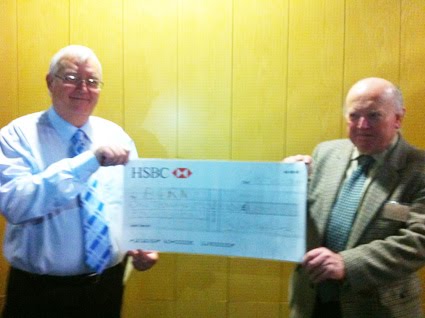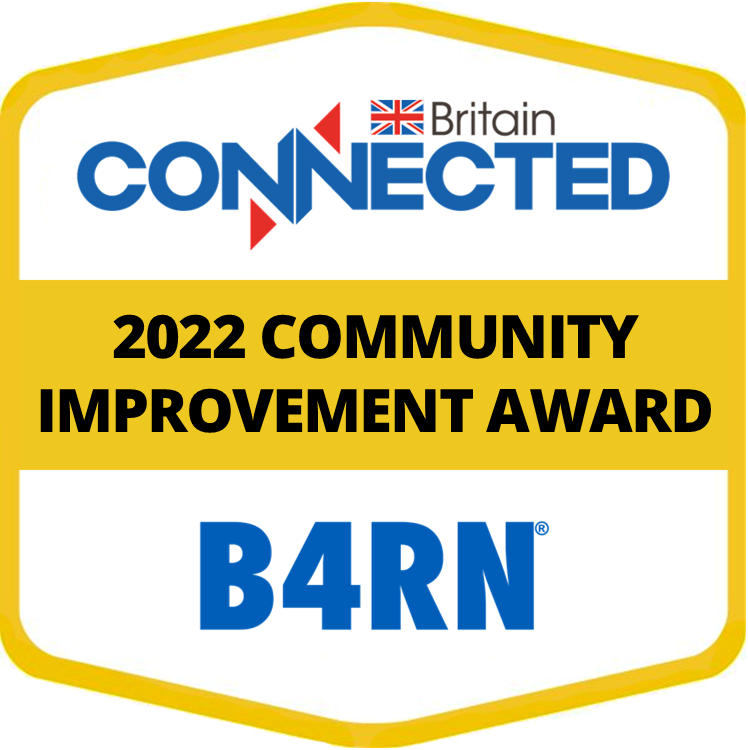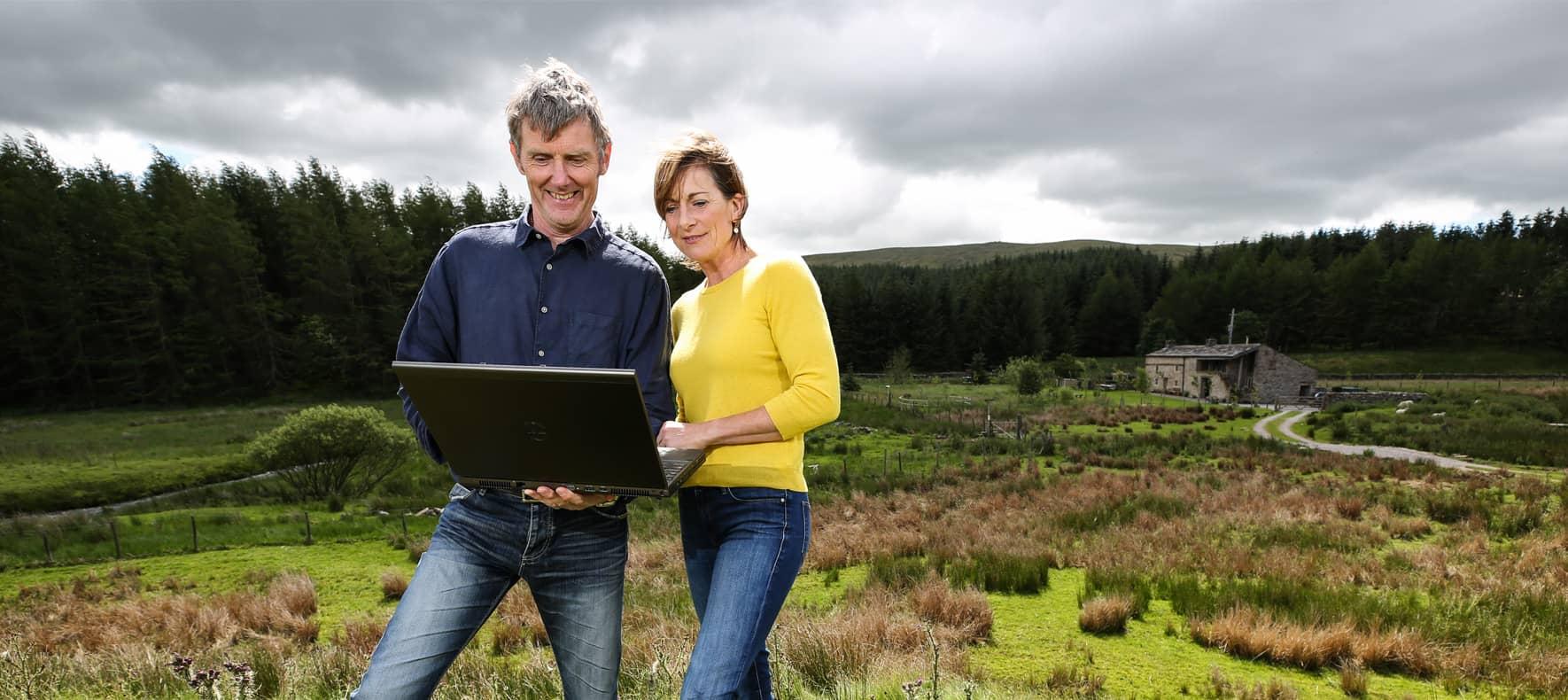10 Years On… B4RN Marks Share Launch Anniversary
December 15th, 2021
Author: Mark Gray
Posted In: Latest news

Then CEO, Barry Forde, and shareholder no.1, Walter Willcox.
Ten years ago B4RN had its share launch with standing room only at The Storey in Lancaster.
The event on 15th December 2011 was a success, with the community-owned full fibre gigabit broadband project capturing the imagination of people not just locally, but around the country and the globe.
Potential investors were promised skills and jobs would be created locally. The B4RN management team back then knew the geography, people and culture with a skill set encompassing technical, legal, financial and community engagement expertise.
Professor Barry Forde, then CEO of B4RN, presented the project and share offer to a packed house, with attendees from the local community, professional organisations, journalists and industry pundits from around the UK.
The then Mayor of Lancaster cut a celebratory cake and the share issue was launched, with the first cheque being presented by Walter Willcox from Surrey.
A decade on, and we’ve spoken to some of the key players about those early days and where B4RN has gone since.
***
Barry Forde, former B4RN CEO
What are your memories of the day itself?
It’s really one of relief. It was a transitional day because there had been a year of solid work getting to the point where you could do a share issue and it was a sense of relief that we got through all the challenges of all the things we have to do to have any chance of building the network at all. That day was the culmination of that. And yes, there was big question marks: would people invest and all sorts of things like that, but we had actually done all the work – it was the transition from ‘OK, we’ve done everything we can conceivably think of to put together a viable package and right now it’s just a case of launching it and and fingers crossed, pray and and all the other things you need to do’.
Can you tell us about some of the work which had gone into it?
Putting together a technical design that was practical, workable, affordable. Remember back in those days, people weren’t doing this sort of stuff. They were doing very traditional dig up the road type models or sling up telegraph poles. So the way we were looking at doing it was fairly radically different. But the reason for doing that was to get the cost into something that we thought was going to be affordable. That was a lot of work to come up with that design and there was a lot of challenge in presenting it in a way that people would not take one look at it and say we’re ‘yogurt knitters’.
It had to be a credible technical design. And although on the one hand we had people like BT saying amateurs can’t build a network, on the other hand, nobody could actually come up with anything that was fundamentally wrong with the design, so that was very important.
Did others believe B4RN was viable?
I remember having meetings with with land agents in a meeting Monica Lee organized and all the land agents were saying farmers will not let you go across their land, they will want money. I was saying ‘well I don’t believe that’ – if it’s a not for profit community project, totally inclusive – all the things that we made a big song and dance about. I believe that the local farmers and land owners will grant wayleaves and, as you know, that turned out to be true.
And some didn’t believe in full fibre?
You look now in 2021 and the whole world is saying you put in fibre but back in 2011, the whole world was saying no. It was only a few niche players, like ourselves. We were a leader in that exercise, whereas now it’s everybody and their dog is doing the same thing. It’s nice to be proved right but back then it was hard work.
Following the share launch did you believe B4RN would take off?
Several things would have to happen. I mean, people would have to invest. People would have to give wayleaves. People would have to agree to dig because in the early days we couldn’t afford to pay contractors.
The real question mark then (and this has been the history of B4RN all the way through) is how much risk can we take? At what point can we start doing what? If you go in too early, the risk is too high. If you wait too long, you might never get there. And somewhere in between is a sweet spot where you’ve brought the risks down to an acceptable level. They’re there, but they’re acceptable, and you’re moving as fast as you can move.
It wasn’t plain sailing in those early days, was it?
I think that year, certainly the first 18 months, I would have said from the share launch through to about, 2013 – I guess it’s actually probably two years – was a fraught period and cash wasn’t coming in anything like fast enough. In those early days the only cash we had was the shares. The amount of money we’re getting in from connection fees and services was piffling. We were really living hand to mouth and we were lucky in a way I had a good relationship with a number of our suppliers.
We were endlessly juggling cash flow and things like that to keep our head above water and then slowly the tide began to turn; and it began to turn in two ways. One is we started to get the connections and we started to get the build out, but then the vouchers started kicking in as well and once the vouchers started kicking in, the whole economics started changing.
Were you confident B4RN would thrive?
I knew what we were doing was right.
But it was white-water rafting. We were heading in the right direction but we were trying to dodge the rocks and the rocks were all over the bloody place. It was really scary.
Somehow we managed to get through it and then we got into the more placid water without the rocks and from then on things grow.
And none of this would be possible without the community?
One of the things that’s different about the rural community to urban is there is a sense of time. Landowners think in much longer time frames than people in Whitehall do and a landowner will plant a tree knowing it’s going to be 80 years and it’s probably his children or his grandchildren are going to be around before they see that tree in its full majesty. They repair walls. They plant hedges that are going to take decades to grow. They do tend to think a lot longer term. So to actually present them with something and say ‘OK, it might be more than you need today, but in 10 years you’ll probably find it’s really come into its own and 50 / 60 / 70 years from now you’ll still be able to use it, which you won’t be able to do with these other services or need umpteen upgrades’. That actually resonates with with the farmers and rural people.
Below: Watch Barry’s share launch presentation from 2011:
Walter Willcox, Investor No.1
What do you remember of the share launch and those early days?
It was quite an eye opener to me to see how many people actually turned up, which gave me some confidence.
I had been in touch with both Lindsey [Annison] and Chris [Conder] for many years and that culminated in a meeting near Warcop. We had a walk round the place – got thoroughly soaked – and repaired to a pub where I announced I was prepared to be an investor.
I didn’t at that stage realise I was going to be called the first investor.
Obviously, there were quite a few more. There must have been enough pledges for Monica [Lee] and for Barry [Forde] to think it was worthwhile.
[A few months later] it ended up with the ‘Day of the Spades’ – an extremely chilly day but, relatively speaking, an enormous number of people turned up and that had a nice glow of confidence in it.
Can you tell us about volunteering for B4RN?
The weather doesn’t help, as indeed it most certainly didn’t help us the first year of B4RN. Field operations were absolutely atrocious. It rained and it rained, and it rained, as it often does in Lancashire.
From my point of view, I was a relative stranger but I was welcomed up there, and that’s what encouraged me to go back up and as well as everything else. Although I’ve got a substantial comms background, I didn’t have any fibre background and it was going to visit them and having short lessons with Tom Rigg and with Barry that got me up to speed sufficiently.
Did you believe B4RN was needed to help close the digital divide?
Oh, there’s absolutely no question whatever. And particularly in parts of rural Lancashire, the Yorkshire Dales and Cumbria. Naturally, diabolical services from [the existing provider] who at that stage had no intention of ever doing anything about it.
For instance, the whole of Arkholme is actually served from the telephone exchange in Hornby. That means that the best that could be provided up there was what’s known as ADSL (asymmetric digital subscriber line). They had no fibre going into local cabinets and only when you’ve done that can you have better VDSL (very fast digital subscriber line) and that in itself is a pretty mediocre service. I mean only 80Mbps down and we’re still only 20Mbps up. That’s if you happen to be directly beside the cabinets and as soon as you go a kilometre away you know the amount available is much, much smaller.
Just opposite your offices in Melling you can look on the top of Leck Fell. On top of that fell there is Leck Fell farm. That now has a B4RN service. I think it was 3 and a half kilometres going to a property that didn’t have any water supply, electricity and certainly no gas. And they’re relying on their own generator and solar solar panels. So I mean, that gives you a concept and there’s no way that another operator would invest the amount of money to put a high speed line 3 and a half kilometres across the jungle (albeit a vertical jungle) and just to serve 1 property.
That is the whole concept that B4RN worked on. They worked on parishes and they expected the parishes to raise sufficient cash at least to get their system up and running. There was an unwritten law that anybody anywhere within that parish was entitled to get a B4RN service, no matter how far away they were.
What do you make of B4RN today?
The major, major thing which has to be admired by everybody is the size of the area, it isn’t just Lancashire now. Having [nearly] 10,000 connections over the vast, empty terrain is really quite astonishing.
***
Monica Lee, Company Secretary
What do you recall about the share launch?
There being an awful lot of planning in it. A lot of my memory was rushing around trying to make sure it happened properly. I was really pleased that it was finally getting off the ground. It was lovely to see so many people there. Quite an exciting time. Lots of enthusiasm. Lots of hope. And it was hope – it was very much up in the air, but there was a feeling of ‘we can do this together’.
Any bumps in the road?
It took quite a while because there was quite a bit of resistance to the idea. Plenty of people thought it was snake-oil salesmanship. That there must be something in it for us without understanding that this really was a community venture, and that was the intention of it, and that the only way it could happen was if the whole community worked together.
And many people thought that wouldn’t happen because the land owners had to donate wayleaves – we couldn’t pay for wayleaves. And if landowners weren’t willing to do that, it wouldn’t work. And then people had to actually get out and volunteer to dig. And we needed funding.
So my role turned more and more into finding funding. Barry’s was designing the network and Chris was hauling in volunteers. We spent some while before we managed to get a management group together, and Bruce [Alexander] was an absolutely star on that. It was quite a while before we felt that we had actually got a real project going.
There were also many attempts by the incumbent provider, who I won’t name, to try and shut us down because they obviously saw us as a competent competitor. We spent a lot of time trying to persuade them and the Council and everybody else that ‘no, we’re reaching the places that no one else can reach’. That we aren’t actually a competitor to any of the big providers because they don’t want to come here. Despite the fact that they were getting extra money to be able to connect and provide service to the hard-to-reach places, they weren’t actually using it to come here.
So, I think, inadvertently, B4RN was only formed as a company in reaction to the fact that they tried to shut us down. There was a lot of frustration, which is a good driver to make action happen, and the only reason why we actually needed B4RN as it is, was because they wouldn’t let us just build on our own. We had to create a company to be able to move forwards and so the feeling of David and Goliath was a very important driver to a lot of people.
Did B4RN grow quickly after the share launch?
It felt like the start of turning the dream into reality. But of course our reality then was quite small. It was 23 parishes and that was it. That’s all we were planning to do and that’s what the community was working for.
And I think what we failed to fully appreciate was the power of the community. I mean, I put the ‘by the community, for the community’ strapline on the headed paper, and genuinely meant that, but failed to fully appreciate how powerful the community was in terms of how the land owners, the volunteers, the diggers, the cake makers, the people who actually invested in it all, would pull together, and when working together in that way, as a community, how much it could get things done.
This was an importantly powerful message it gave to other communities. Which is to say: ‘Build towards us and we we will help you build.’
[The ‘Day of the Spades’] was the start of the real, proper digging and that was the start of the route we follow now. And no, we never imagined it could go further. It was a powerful message, which now has interest from across the world several times over and over, because we are pretty unique in terms of a community venture.
Customer Testimonial
We’re award winners!















